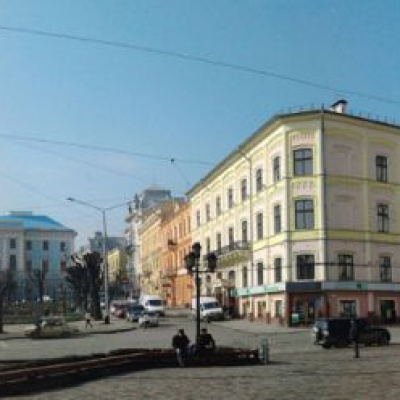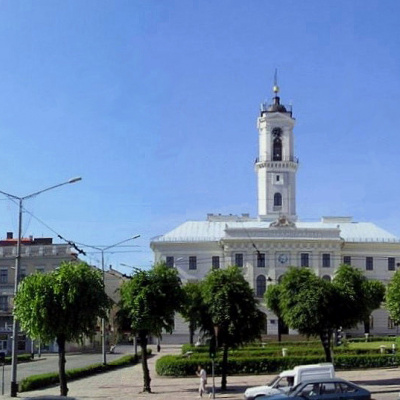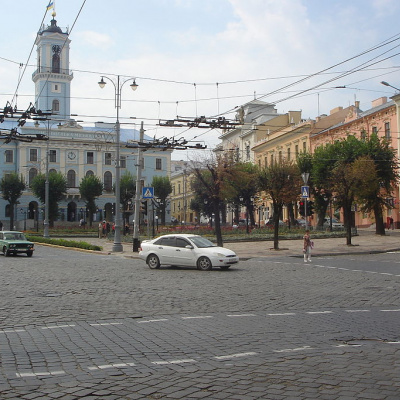Central Square, Chernivtsi
Central Square (Chernivtsi) is the main square of Chernivtsi, the center of the city. The present-day Central Square of Chernivtsi was officially called Ringplatz (Market Square) until 1918, Piata Unirii (Reunification Square) until 1940, Red Square until 1949, and Central Square since 1949.
Almost all the main streets of the city diverge from the Central Square like rays: Holovna, Ruska, Universytetska, Ivan Franko, Olha Kobylianska, as well as Mihai Eminescu and Poshtova streets. From 1897 to 1966, a tram line ran through the central square of Chernivtsi, connecting the northern and southern parts of the city. Since 1966, the trolleybus has been the main public transportation in the city.
The trolleybus as a means of transportation began to be used in Chernivtsi in 1939.
There was one line #4: from the metropolitan's residence along Universytetska and Ruska streets, crossing the central square to Zelena street. Now there are five trolleybus routes running through Central Square: No. 3 and No. 5 - connecting the northern and southern parts of the city (Prut River area, Sadhora to the bus station area); No. 1 - connecting the eastern part of the city and the residential area on Nezalezhnosti Avenue; No. 2 and No. 4 (partially a pre-war route, extended) - connecting the western and eastern parts of the city. Some minibuses pass through Central Square. In the pre-war period, buses used to run there.
The Central Square (Ringplaz (Market) Square) was created by Emperor Joseph II. During his first visit to Chernivtsi in June 1783, he offered the magistrate a place for the market square and categorically ordered the demolition of the huts located there. On July 27, 1796, the Galician governorate ordered the Bukovyna district administration to develop a plan for a new square. Negotiations between the city court, the Bukovyna district administration, the Galician governorate, and the owners of the land plots needed to create the square were quite tense and lasted a long time.
Decisions on the purchase of land plots and payment of their value were considered in the Chernivtsi City Court from 1800 to 1832. According to the developed plan, it was necessary to create a large free area, taking into account the regularity of connections between the central and side streets, which should become a safe place for holding trades and fairs and, ultimately, a decoration of the city.
The improvement of Rynok Square began in 1825, after Adolf Marin was appointed regional engineer. First, the square was leveled, then the pavement was laid - the square was first paved in 1840 (the pavement was replaced over time). The completed work was accepted by a special commission.
The central building of the square's architectural ensemble is the building of the Chernivtsi City Council(Chernivtsi City Hall). It was built in 1843-1847 by Andriy Mikulich in the late classicist style. In terms of composition, the building is traditionally designed for city halls. The building is close to a square and has a courtyard. A two-tiered tower with a balcony, decorated with a clock and a copper spire with a flagpole, rises above the entire building.
Until the 1920s, the tower was topped by a three-meter-high gilded eagle. During renovations in 1903, 20 coins and a letter to descendants were placed in the ball under the eagle. The fate of these relics is currently unknown. The eagle was removed by the Russians in 1916 during the First World War.
From the balcony that surrounds the tower on all sides, you can clearly see the entire city. Of course, in the old days, the balcony did not serve as a platform for viewing the surroundings, but had a very practical purpose: it was a place for fire watch. Today, every day, at exactly 12 o'clock, the melody of the popular song "Marichka" by the Bukovynian composer Stepan Sabadash, played on the trumpet by a trumpeter in Bukovynian folk costume, is heard from the tower's balcony to all four sides of the city.
In the Austrian era, the spire of the tower with a gilded copper ball was crowned with a "bird"-a two-headed Habsburg eagle. During the First World War, when the city changed hands many times, the "bird" was dismantled. Since then, many flags have changed on the spire, as well as the inscriptions on the building's pediment. But the town hall has always served as the center of city government. In the early twentieth century, the central square was home to a number of hotels-now none exist.
The Russie stood on the site of today's Art Museum (to the right of the town hall), the Weis stood a little to the side of the town hall, and the Schwarzer Adler (Black Eagle) stood at the corner of the square and the beginning of the present-day Universytetska Street. The latter was originally a one-story building, later rebuilt and extended to a three-story building, and was considered the most prestigious: all famous guests and government officials who arrived in Chernivtsi stayed here. This hotel existed for the longest time, in Soviet times under the name Verkhovyna, and only recently became the main building of the Chernivtsi Institute of Trade and Economics.
The imposing three-story building of the current Art Museum was built in 1900-1901 on the site of the Russie Hotel as a building of the Bukovyna Savings Bank ("Bukowiner Sparkass"). The building was designed by the Viennese architect Hubert Gessner and is considered a classic example of Viennese Secession (Art Nouveau), one of the most exquisite Art Nouveau monuments in Central and Eastern Europe. The building has clear symmetries of the facade, against which the central risalit slightly protrudes, crowned by an attic with two sculptures on the edges. Among the façade decorations, a majolica panel adorning the upper part of the central risalit stands out.
The panel depicts allegorical figures - 12 ancient gods symbolizing the 12 crowned provinces of Austria-Hungary. Austria itself is depicted as a girl in a purple chlamydia in the center of the panel, and Bukovyna is symbolized by a young man with a horse in a goat's skin. The art museum also impresses with the equally exquisite beauty of its interiors, which masterfully combine sculpture, painting, stucco, stained glass, and artistic metal. The famous Ukrainian artist Mykola Ivasyuk took part in the interior decoration of the building. He painted a mythological painting that still adorns the ceiling.
The exposition of the art museum allows you to trace the development of painting in Bukovyna over the past two centuries. The classical school is represented by paintings by Justin Pihulyak, Mykola Ivasyuk, Yevhen Maksymovych, Augusta Kokhanovska, and other artists whose works adorn museums and art galleries in many European cities.
The Mihai Eminescu Romanian Cultural Society is located next to the building of the current Art Museum. This building was built in the 50s of the XIX century and served as the mansion of the governor of Bukovyna (Landespräsident); Emperor Franz Joseph stayed here during his visit to Chernivtsi in 1855. Later it was used as the Weiss Hotel and was bought by the Romanian Society for the Romanian National House (Rumänisches Nationalhaus).
Opposite the former hotel "Pid Chornyi Orlom" (on the second corner of the square and the present-day Universytetska street), a luxurious five-story building of the Golden Lion Hotel was built in 1910. Today, it houses shops and living quarters, as well as departments and a university dormitory. The only reminder of the former hotel is the bas-relief of a lion standing in a heraldic pose at the top of the corner tower.
At the corner of today's Ruska and Holovna streets was the Hotel Paris, which also had stables in its courtyard. Now it is the Goods for Youth store. The Paris Hotel had 10 rooms, 4 of which were double rooms. There was also a coffee shop and two stables for 30 horses. During the First World War, the hotel was occupied by the military.
The eastern side of the square was once called the Pardini Hill, as the famous Pardini Bookstore was located here. Further on, at the corner of Kobylyanska and Tsentralna Square, the building of the former Habsburg coffee shop (with secessionist interiors no worse than in Vienna or Paris) still pleases the eye. Now it houses a branch of the National Bank of Ukraine.
Opposite the cafe (between the present-day Olha Kobylyanska and Holovna streets) was the building of the Belle Vue Hotel ("beautiful view"). Indeed, the balcony of this hotel offered a beautiful view of the entire Rynok Square, which was a favorite meeting place for Chernivtsi residents, a kind of "city within a city."
Today, the Central Square has not lost its beauty and attractiveness and remains one of the best squares in the city.
Chernivtsi is the capital of Bukovyna. It is one of the most beautiful and pleasant Ukrainian cities. There is one of the most beautifulrailway stations in the country, theChurch of St. Paraskeva of Serbia, the Church of the Exaltation of the Cross, the ship house, the City Hall (every day at 12:00 a trumpeter plays the melody of "Marichka" from the tower), the Art Museum, then Kobylianska Street, the German Folk House, the Armenian Church and the Assumption Church (the oldest stone Ukrainian Greek Catholic Church in Chernivtsi), the Theater Square and the Kobylianska Theater. Kobylianska Theater Square, Jewish People's House, Chernivtsi University (included in the UNESCO World Heritage List), Turkish Square (Chernivtsi has been a part of Turkey, Modova, Romania, Austria-Hungary, the USSR, Rus, and Ukraine), and a large rover,cozy streets and cobblestone streets, the so-called Drunken Church, Nazariy Yaremchuk's house, then another house-ship, two houses with the same number (Olha Kobylianska lived here), the house where Volodymyr Ivasyuk lived, the pink church - the Cathedral of the Holy Spirit.
Chernivtsi sights
- St. Nicholas wooden church (from 1607, restored in 1954);
- stone Church of St. George on the Bitterroot (1767 in the Baroque style);
- wooden Trinity Church in Muggles (one thousand seven hundred and seventy-four), moved in 1874 to Kłokuchka;
- wooden Assumption Church on Kaleczanka (1783);
- City Hall with a two-story, 45-meter-high Empire-style tower (1843-1847, architect A. Mykulych), now the City Council;
- Ukrainian Greek Catholic Church (1825-1830 in the Baroque style);
- Byzantine-style cathedral (1844-1864, architect Roll);
- Church of St. Paraskeva in the pseudo-Romanesque style, completed in 1662 (architect A. Pavlovsky);
- residence of Bukovyna metropolitans - since 1956 one of the buildings of Chernivtsi University);
- Armenian Gregorian Church (1869-1875, architect J. Hlavka);
- Chernivtsi University building (1874-1875);
- Jesuit church in the Neo-Gothic style (1893-1894);
- Railway station (1898-1903) in the Art Nouveau style;
- the City Theater (1904-1905, architects F. Fellner and G. Helmer) in the Viennese Baroque style with Art Nouveau elements (now the O. Kobylianska Music and Drama Theater), etc.







